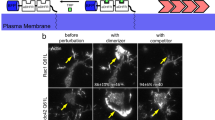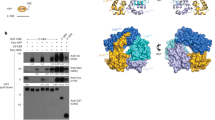Abstract
Mammalian Dock180 and ELMO proteins, and their homologues in Caenorhabditis elegans and Drosophila melanogaster, function as critical upstream regulators of Rac during development and cell migration. The mechanism by which Dock180 or ELMO mediates Rac activation is not understood. Here, we identify a domain within Dock180 (denoted Docker) that specifically recognizes nucleotide-free Rac and can mediate GTP loading of Rac in vitro. The Docker domain is conserved among known Dock180 family members in metazoans and in a yeast protein. In cells, binding of Dock180 to Rac alone is insufficient for GTP loading, and a Dock180–ELMO1 interaction is required. We can also detect a trimeric ELMO1–Dock180–Rac1 complex and ELMO augments the interaction between Dock180 and Rac. We propose that the Dock180–ELMO complex functions as an unconventional two-part exchange factor for Rac.
This is a preview of subscription content, access via your institution
Access options
Subscribe to this journal
Receive 12 print issues and online access
$209.00 per year
only $17.42 per issue
Buy this article
- Purchase on Springer Link
- Instant access to full article PDF
Prices may be subject to local taxes which are calculated during checkout








Similar content being viewed by others
References
Hasegawa, H. et al. DOCK180, a major CRK-binding protein, alters cell morphology upon translocation to the cell membrane. Mol. Cell Biol. 16, 1770–1776 (1996).
Cheresh, D. A., Leng, J. & Klemke, R. L. Regulation of cell contraction and membrane ruffling by distinct signals in migratory cells. J. Cell Biol. 146, 1107–1116 (1999).
Klemke, R. L. et al. CAS/Crk coupling serves as a “molecular switch” for induction of cell migration. J. Cell Biol. 140, 961–972 (1998).
Kiyokawa, E. et al. Activation of Rac1 by a Crk SH3-binding protein, DOCK180. Genes Dev. 12, 3331–3336 (1998).
Kiyokawa, E., Hashimoto, Y., Kurata, T., Sugimura, H. & Matsuda, M. Evidence that DOCK180 up-regulates signals from the CrkII–p130(Cas) complex. J. Biol. Chem. 273, 24479–24484 (1998).
Fukui, Y. et al. Haematopoietic cell-specific CDM family protein DOCK2 is essential for lymphocyte migration. Nature 412, 826–831 (2001).
Albert, M., Kim, J. & Birge, R. αvβ5 integrin recruits the CrkII–Dock180–Rac1 complex for phagocytosis of apoptotic cells. Nature Cell Biol. 2, 899–905 (2000).
Gumienny, T. L. et al. CED-12/ELMO, a novel member of the CrkII/Dock180/Rac pathway, is required for phagocytosis and cell migration. Cell 107, 27–41 (2001).
Duchek, P., Somogyi, K., Jekely, G., Beccari, S. & Rorth, P. Guidance of cell migration by the Drosophila PDGF/VEGF receptor. Cell 107, 17–26 (2001).
Erickson, M. R., Galletta, B. J. & Abmayr, S. M. Drosophila myoblast city encodes a conserved protein that is essential for myoblast fusion, dorsal closure, and cytoskeletal organization. J. Cell Biol. 138, 589–603 (1997).
Nolan, K. M. et al. Myoblast city, the Drosophila homolog of DOCK180/CED-5, is required in a Rac signaling pathway utilized for multiple developmental processes. Genes Dev. 12, 3337–3342 (1998).
Reddien, P. W. & Horvitz, H. R. CED-2/CrkII and CED-10/Rac control phagocytosis and cell migration in Caenorhabditis elegans. Nature Cell Biol. 2, 131–136 (2000).
Wu, Y. C. & Horvitz, H. R. C. elegans phagocytosis and cell-migration protein CED-5 is similar to human DOCK180. Nature 392, 501–504 (1998).
Wu, Y. C., Tsai, M. C., Cheng, L. C., Chou, C. J. & Weng, N. Y. C. elegans CED-12 acts in the conserved crkII/DOCK180/Rac pathway to control cell migration and cell corpse engulfment. Dev. Cell 1, 491–502 (2001).
Zhou, Z., Caron, E., Hartwieg, E., Hall, A. & Horvitz, H. R. The C. elegans PH domain protein CED-12 regulates cytoskeletal reorganization via a Rho/Rac GTPase signaling pathway. Dev. Cell 1, 477–489 (2001).
Lundquist, E. A., Reddien, P. W., Hartwieg, E., Horvitz, H. R. & Bargmann, C. I. Three C. elegans Rac proteins and several alternative Rac regulators control axon guidance, cell migration and apoptotic cell phagocytosis. Development 128, 4475–4488 (2001).
Hall, A. Rho GTPases and the actin cytoskeleton. Science 279, 509–514 (1998).
Ridley, A. Rho family proteins: Coordinating cellular responses. Trends Cell Biol. 11, 471–477 (2001).
Van Aelst, L. & D'Souza-Schorey, C. Rho GTPases and signaling networks. Genes Dev. 11, 2295–2322 (1997).
Cerione, R. A. & Zheng, Y. The Dbl family of oncogenes. Curr. Opin. Cell Biol. 8, 216–222 (1996).
Hart, M. J., Eva, A., Evans, T., Aaronson, S. A. & Cerione, R. A. Catalysis of guanine nucleotide exchange on the CDC42Hs protein by the dbl oncogene product. Nature 354, 311–314 (1991).
Vetter, I. R. & Wittinghofer, A. The guanine nucleotide-binding switch in three dimensions. Science 294, 1299–1304 (2001).
Kobayashi, S. et al. Membrane recruitment of DOCK180 by binding to PtdIns(3,4,5)P3. Biochem J. 354, 73–78 (2001).
Nishihara, H. et al. Non-adherent cell-specific expression of DOCK2, a member of the human CDM-family proteins. Biochim. Biophys. Acta 1452, 179–187 (1999).
Worthylake, D. K., Rossman, K. L. & Sondek, J. Crystal structure of Rac1 in complex with the guanine nucleotide exchange region of Tiam1. Nature 408, 682–688 (2000).
Liu, X. et al. NMR structure and mutagenesis of the N-terminal Dbl homology domain of the nucleotide exchange factor Trio. Cell 95, 269–277 (1998).
Soisson, S. M., Nimnual, A. S., Uy, M., Bar-Sagi, D. & Kuriyan, J. Crystal structure of the Dbl and pleckstrin homology domains from the human Son of sevenless protein. Cell 95, 259–268 (1998).
Aghazadeh, B. et al. Structure and mutagenesis of the Dbl homology domain. Nature Struct. Biol. 5, 1098–1107 (1998).
Shinohara, M. et al. SWAP-70 is a guanine-nucleotide-exchange factor that mediates signalling of membrane ruffling. Nature 416, 759–763 (2002).
Snyder, J. T. et al. Quantitative analysis of the effect of phosphoinositide interactions on the function of Dbl family proteins. J. Biol. Chem. 276, 45868–45875 (2001).
Walk, S. F., March, M. E. & Ravichandran, K. S. Roles of Lck, Syk and ZAP-70 tyrosine kinases in TCR-mediated phosphorylation of the adapter protein Shc. Eur. J. Immunol. 28, 2265–2275 (1998).
Nemergut, M. E., Mizzen, C. A., Stukenberg, T., Allis, C. D. & Macara, I. G. Chromatin docking and exchange activity enhancement of RCC1 by histones H2A and H2B. Science 292, 1540–1543 (2001).
Tosello-Trampont, A., Brugnera, E. & Ravichandran, K. S. Evidence for a conserved role for CrkII and Rac in engulfment of apoptotic cells. J. Biol. Chem. 276, 13797–13802 (2001).
Acknowledgements
We thank J. Casanova, T. Parsons and U. Lorenz for critically reading the manuscript and members of the Ravichandran laboratory for helpful suggestions and comments. We thank C. Der and T. Karnoub for generously providing us with the RacW56F mutant. This work was supported in part by an American Cancer Society grant to K.S.R.
Author information
Authors and Affiliations
Corresponding author
Ethics declarations
Competing interests
The authors declare no competing financial interests.
Supplementary information
Supplementary figure
Supplemental Figure 1. Coprecipitation of Docker domain with GST-Rac. (PDF 105 kb)
Rights and permissions
About this article
Cite this article
Brugnera, E., Haney, L., Grimsley, C. et al. Unconventional Rac-GEF activity is mediated through the Dock180–ELMO complex. Nat Cell Biol 4, 574–582 (2002). https://doi.org/10.1038/ncb824
Received:
Revised:
Accepted:
Published:
Issue Date:
DOI: https://doi.org/10.1038/ncb824
This article is cited by
-
Loss of Myo19 increases metastasis by enhancing microenvironmental ROS gradient and chemotaxis
EMBO Reports (2024)
-
circRNA432 enhances the coelomocyte phagocytosis via regulating the miR-2008-ELMO1 axis in Vibrio splendidus-challenged Apostichopus japonicus
Communications Biology (2023)
-
Internalization of apoptotic cells during efferocytosis requires Mertk-mediated calcium influx
Cell Death & Disease (2023)
-
Targeting Ras-binding domain of ELMO1 by computational nanobody design
Communications Biology (2023)
-
Role of RhoG as a regulator of cellular functions: integrating insights on immune cell activation, migration, and functions
Inflammation Research (2023)



